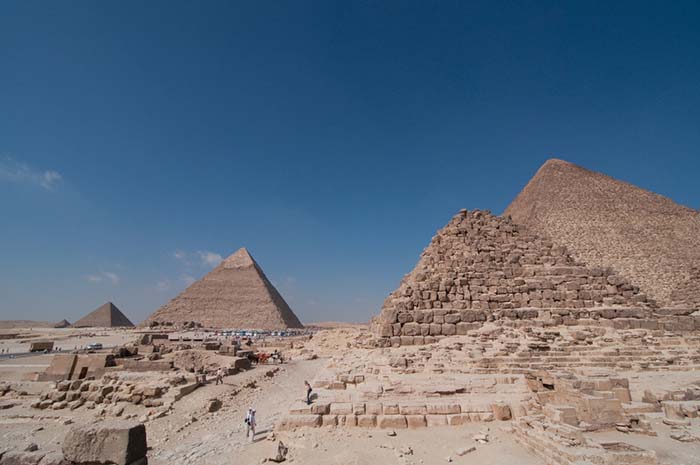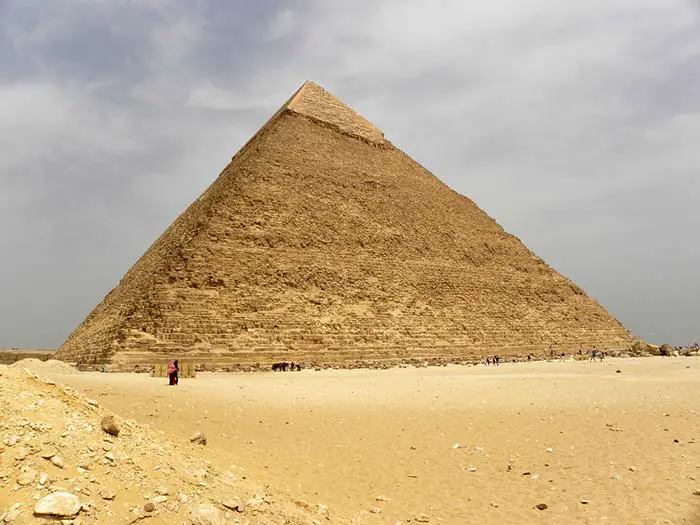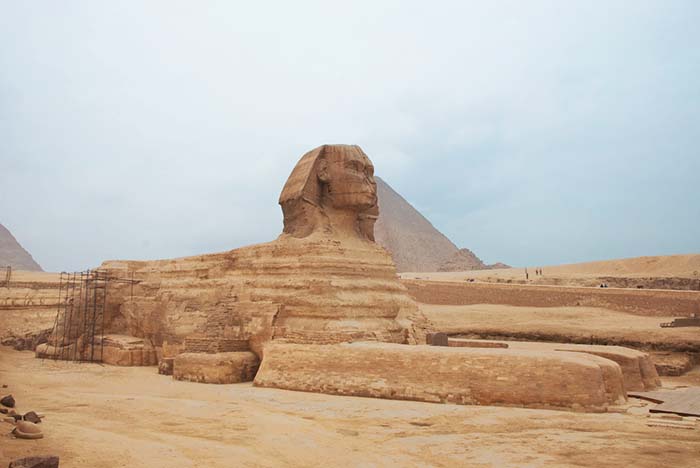The Pyramids of Giza
The Giza Complex, located just outside Cairo, has been a major attraction in Egypt for decades. It is one of the best known tourist destinations in the world when it comes to visiting ancient structures.
Although based near the Egyptian capital, the complex is surrounded by desert, which gives quite a surreal experience and a feeling of being transported back to the ancient times.
There are six pyramids in the complex, three large and three smaller ones. Nearby, there’s the Sphinx and workers’ village as well as cemeteries. The entire site is also known as the Giza Necropolis.

© Robert Young - The Giza Necropolis
The Great Pyramid of Khufu
This massive pyramid is the largest ever built. It stands at 481 feet (147 meters) and was erected about 4,500 years ago during the Old Kingdom. Over two million stone blocks were used to construct it, each weighing several tons. This is where Khufu, the ruler of the 4th dynasty, was buried.
There are three chambers within this pyramid. One is where the pharaoh’s sarcophagus was located and the entrance to it leads through a Grand Gallery that was initially blocked by sliding granite blocks to prevent Pharaoh Khufu’s chamber from being looted.
The second chamber, located above the ground, was initially believed to be the Queen’s burial site, but now the archaeologists believe it to be a place where a sacred statue of the ruler was located. There’s also an underground chamber which is carved into a rock.
This pyramid was built to serve as the center of a larger complex, composed of smaller structures such as several smaller pyramids, a mortuary, tombs for members of the royal family and high officials, as well as boat pits, a causeway, and a valley temple.
The archaeologists also discovered several shafts, which are believed to have been constructed for the purpose of allowing the Pharaoh’s passage to the afterlife.
Click here to learn more about the Great Pyramid...

© Never House - The Great Pyramid
The Pyramid of Khafre
This is the second tallest pyramid among the Pyramids of Giza. It’s shorter by just 30 feet (10 meters) than the Pyramid of Khufu and is made with limestone blocks. It was made for Pharaoh Khafre, a son of Khufu.
Two chambers were discovered in this structure. One is located below the ground and in carved in the bedrock. It’s the subsidiary chamber and has entrance from the lower side. The other entrance into the pyramid, from the upper side, leads to the Burial Chamber that holds a sarcophagus.
Inside the structure, jars formed as protective spirits were discovered. This is where the body parts of the deceased were stored.
The pyramid was entered into and looted back in the ancient times. As a matter of fact, there’s a recording from the 14th century of its opening, so discovering the inside of the pyramids isn’t exclusively the thing of modern times.

© Karen - Pyramid of Khafre
The Pyramid of Menkaure
Among the three largest Pyramids of Giza, the Pyramid of Menkaure is the smallest one. Its height is around 200 feet (60 meters) and it was constructed with granite and limestone. Its completion date is estimated around the 25th to 26th century BC.
Menkaure was the ruler of the 4th dynasty, yet his pyramid is only one tenth the size of the largest pyramid. Menkaure’s sarcophagus was excavated back in the 19th century and sent on the way to England. However, it sank in the sea together with the ship.
In addition, to the South the pyramid, there are three satellite pyramids, thus the Pyramids of Giza complex is composed of six structures.

© NekaPearl - Pyramid of Menkaure
The Great Sphinx of Giza
Next to the Pyramids of Giza, visitors find one the most well-known and exciting ancient structures: The Great Sphinx. It stands at nearly 250 feet (74 meters) in length, over 60 feet (20 meters) in width, and nearly 70 feet (over 20 meters) in height. This imposing statue is carved of a single limestone and is the largest monolith statue in the world.
The generally accepted belief is that the Sphinx was built during the reign of Pharaoh Khafre, but many controversial theories have been presented. While the human face of the giant structure does seem to resemble the appearance of Khafre, archaeologists showed links to the reign of other pharaohs, some even pointing to the end of the archaic period. Conclusive evidence is yet to be found.
Present day visitors will notice that the face of the Sphinx is quite damaged. Although no building stands intact over many centuries, some blame the French soldiers under Napoleon who supposedly used it as a target for artillery practice.
According to a myth, in the ancient times the Sphinx was a mystical creature which gave visitors a riddle to answer. Those who couldn’t answer it were devoured by this terrifying lion-man. As the legend goes, the Sphinx asked who walks on four legs in the morning, three at noon, and two in the evening. The proper answer was: the man.
The explanation is that when we’re babies, we crawl. As adults we walk erect, and finally, as old people, we use a cane. On the humorous side, it’s still not known how many travelers the Sphinx had eaten.
Click here to learn more about the Great Sphinx...

© Ian McKellar - The Great Sphinx
The Giza Complex Cemeteries
There are three cemeteries in the Giza Complex: The Western Cemetery, the Eastern Cemetery, and a third smaller one to the south. The graves are arranged in the form of streets and avenues.
Initially, this is where the wives and children of the 4th dynasty’s rulers were buried. The cemeteries were expanded during the 5th and 6th dynasties, and now multiple burial sites are found within this complex. In a couple of graves the prophets of the rulers were buried as well.
Workers’ Village
About 1,300 feet (400 meters) South of the Sphinx, there’s an ancient Workers’ Village. It housed 10,000 workers responsible for erecting the Pyramid of Menkaure. It contains chambers for sleeping and cooking, and a nearby workers’ cemetery.
Ancient pottery and animal bones were excavated in recent years. There’s also evidence that these workers received medical care, as remains of healed bones and amputated limbs indicate. Evidence of copper working was also discovered, making this place relatively advanced for its times.

© Phil - Remains of the workers' village at Giza
Key Facts about the Pyramids of Giza
- The Pyramids of Giza were built 4,500 years ago and are an amazing architectural accomplishment during the ancient times.
- The Pharaohs of the 4th dynasty are buried there.
- The Great Sphinx is the largest monolith statue in the world
- The Giza Complex contains cemeteries arranged in the form of cities with streets and avenues.
- Workers constructing the pyramids received medical treatment and even surgical operations are believed to had been performed there.

